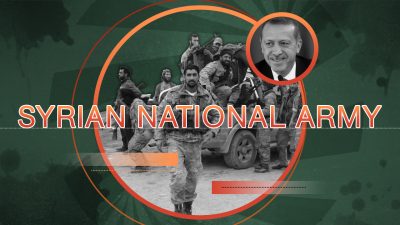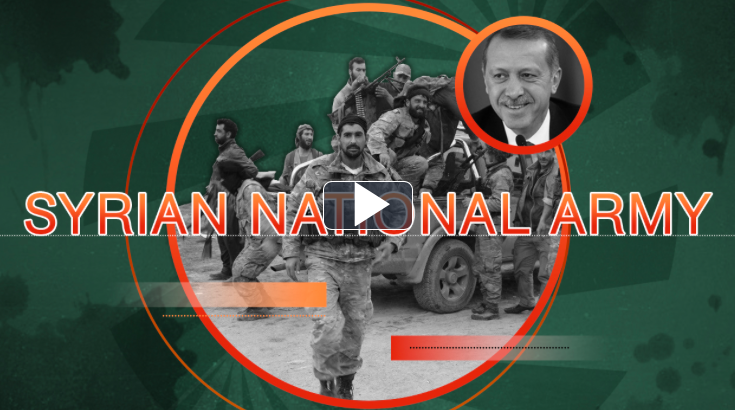Video: Turkish-funded Syrian National Army and Myth of United Syrian Opposition

Turkey’s Operation Peace Spring once again drew wide attention not only to the so-called Kurdish question, but also to attempts by Ankara to create a unified Syrian opposition as an alternative to the Assad government. According to official Turkish statements, the goal of the operation is to secure the southern Turkish border defeating “the terrorism” and allow up to 2 million of refugees to return to their homes. Nonetheless, there are no doubts that the operation, like previous military actions in the provinces of Aleppo, Lattakia and Idlib, will be used by Turkey to expand its own influence.
The Turkish-based Syrian Interim Government headquartered and Turkish-affiliated militant groups would be used as a tool of projecting Turkish military and political influence in the area. The Syrian National Army (SNA) are a brand of militant groups participating in the northeastern Syria offensive. Turkey’s Operations Olive Branch and Euphrates Shield demonstrated that the main goal of such groups is to serve as cannon folder on first line of the battle, while aircraft, battle tanks, artillery and special forces units of the Turkish Armed Forces do the main work. This allows Ankara to pretend that its actions in Syria are not military occupation, but a move needed to return the territory to the moderate Syrian opposition that opposes the ‘illegitimate regime’ of President Bashar al-Assad.
In the area of Greater Idlib, Turkish-backed factions formed the National Front for Liberation in May 2018, which was promoted as a moderate opposition coalition that would limit the influence of Hayat Tahrir al-Sham and other al-Qaeda-linked groups. Despite claiming to have 70,000 fighters (sic), the coalition immediately lost a struggle for power to its al-Qaeda counterparts and became a subordinate to Hayat Tahrir al-Sham. In 2018 and 2019, groups from the National Front for Liberation repeatedly participated in al-Qaeda operations against the Syrian Army.
In northern Aleppo, Ankara was more successful because the SNA formed in December 2017 operates only in the Turkish Army area of operations and much more depends on the logistical and supply infrastructure created by Turkish special services. Since its creation, the SNA has included 30 groups with lofty names like the Army of Elite or the First Brigade Command and a very few trained personnel. Despite this, the formation, according to different estimates, includes from 15,000 to 25,000 fighters. Its members participated in Operation Olive Branch and successfully continued receiving salaries ($300-400 per month) after it. Now, they are involved in the operation in northeastern Syria.
Just a few days ahead of the start of Operation Peace Spring, Turkey attempted to unite the National Front for Liberation and the Syrian National Army. On October 4, the groups even released a statement claiming that they had merged. A few hours after the release, fierce clashes between the groups erupted over properties seized in the Afrin area. This put an end to the unification efforts at least for now.
Another problem is that the Turkish-based Syrian Interim Government and especially its Defense Ministry have no real influence on SNA detachments because it had no levers of influence over funds, weapons, ammunition or even orders that they receive. The full control over these sides of the SNA life allows Ankara to successfully manipulate them, when these groups are needed to some military action. At the same time, this approach undermines attempts to create a unified command to manage these groups because commanders of these groups are constantly engaged in an internal struggle for control over weapons and money flow from their Turkish backers.
This explains why immediately after the end of the active phase of Operations Euphrates Shield and Olive Branch, the SNA dispersed into competing armed groups mostly concerned by looting properties in the seized areas and protecting racketeering of local business and markets. Therefore, the Turkey-controlled part of northern Syria was turned into a safe haven for drugs and weapons trafficking, and organized crime. Turkey’s iron hand once again turned competing gangs into a united force under the SNA brand for Operation Peace Spring. However, as soon as, the active phase of operation ends, the Turkish-controlled part of northeastern Syria will experience consequences similar to those faced by territories captured by Turkish-led forces in 2016-2018.
*
Note to readers: please click the share buttons above or below. Forward this article to your email lists. Crosspost on your blog site, internet forums. etc.
We call upon Global Research readers to support South Front in its endeavors.
If you’re able, and if you like our content and approach, please support the project. Our work wouldn’t be possible without your help: PayPal: [email protected] or via: http://southfront.org/donate/ or via: https://www.patreon.com/southfront


